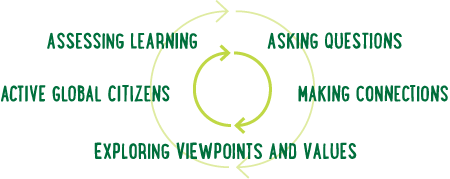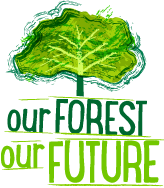How to use this resource...
Our Forest, Our Future helps teachers and pupils to explore the interdependence of people and forests and the vital role forests play in sustaining our environment – in the past, the present and hopefully the future.
The Scots Pine forests in Scotland and the Congo Basin rainforest in Africa provide case studies through which pupils will begin to understand why our forests are under threat and the implications for our planet. Further information about these forests is provided in the following documents.
In making connections between consumerism, people and the environment, pupils will be encouraged to see how they and their actions have an impact on the lives of others globally. It encourages reflection on the possible futures of the world's forests and ways of taking positive actions for a future where people and forests co-exist in a sustainable way.
The resource is structured around a global citizenship framework devised by Oxfam.
More detail on the framework can be found in Global Learning Framework [pdf]
The reflection and evaluation sections in each activity support formative assessment and ongoing monitoring of pupils learning.
Additional assessment opportunities are indicated by... 
Outdoor learning opportunities are indicated by... 
Homework activities are indicated by... 

Taking Action for Change
Education for Global Citizenship is committed to enabling pupils to bring about positive actions for change either locally or globally. This process should support pupils to make their own informed choices through a critical evaluation of the options open to them and the possible implications of those choices.
Throughout the resource there are ideas for possible actions, such as reflecting on our power as consumers, peer education and tree planting. Your pupils themselves should be encouraged to think creatively about the many actions they could take, critically evaluate the impact these actions might have and then evaluate what they have done.
The materials below support your pupils through this process.
> Active global citizens
12. Wood survey
What you need:
Activity A
Activity B
- List of items pupils have collected
- Graph paper or squared paper
- Protractors – if drawing pie charts
Aims
To investigate what kind of products are made from wood and how many are used in our everyday lives.
To explore the different types of products that are derived from trees
To represent data in different ways
Activity A
What to do
Brainstorm as a class wood products used in daily life, in school, at home etc. Their ideas might come from the activity 'How we use the world's forests'.
In pairs, list items in the classroom that are made from wood. They will have 2 minutes to make a list while looking around but staying in their seat and another 2 minutes to walk around the classroom to add to their list. Each pair will get one point for a product that is made from wood but that another pair also wrote down and five points if they get a product made of wood that no other pair wrote down.
When feeding back as a class ask each pair to give a product they have written down. If any other pair also has the item on their list, they put up their hands. Ask the pupils to record their points next to each item so they can add up at the end and see which pair has got the most points.
Discuss with the class the other products that are derived from trees. Some of these, such as paper based products, might have already been mentioned. Use the worksheet, 'the journey of wood' to find out about cellulose, resins, gums and paper which also come from trees.
Using worksheet 'There is a tree in my house' they can find and record as many different products from trees in their home as possible. They will record the results and share them with the class after an agreed period of time. A challenge could be to find a product that no one else has.
These results can be recorded and analysed in various ways. See activity B.
Teacher prompts
- Think about furniture, sports equipment, and musical instruments
- What is in your pencil case? What equipment do we use at school?
- What is the building made of? Can we find out?
Activity B
What to do
When the pupils have brought back in their lists of wood products they need to be organised and displayed in some way.
Ask pupils to discuss with a partner different ways they can think of grouping the information they've collected.
Some ideas are:
- By the areas of our life in which we use them e.g. recreation, shelter, food
- By type e.g. wood products, paper products, products containing cellulose
Once they've chosen the way they are going to group the data they will need to decide how to display this, firstly they can display it by using a table.
To start with get each pupil to display it in table form. With column headings as the different groups e.g.
Recreation
Shelter
Food
The pupils may think of more or different categories of their own.
Now they can think of how to share the information that have collected. In pairs ask them to discuss different ways of displaying data. In displaying the data they want to show visually what they have found out and make it easy for people to make comparisons.
Some ideas of ways they might display their information are:
- BAR CHART – a different bar for each of the headings in their table, plotting the number of products under each one –they could draw examples of the items on the bars.
- PIE CHART– this would work in the same way as the bar chart – a different section of the pie chart for each heading of the table, they could add pictures to the pie chart of examples of the items.
- PICTOGRAM – display the type of different products using a picture and a key for how much each picture represents e.g. a guitar represents 2 recreation products so for 7 recreation products they would draw three and a half guitars.
Teacher prompts
- What is important about the way we display information? It is clear, it is not misleading and it allows comparison.
- What information do you need to write on your display to make it clear?
Reflection and evaluation
- Were you surprised by any of the products that can be made from wood?
- How reliant do you think we are on wood and wood products?
- How do you feel about trees being used for so many different things in our lives?
- How would you manage if the forests were all destroyed and we didn't have many trees to make all these products from?
![]() Teacher info
Scots Pine forest [pdf]
Teacher info
Scots Pine forest [pdf] ![]() Teacher info
Congo Basin rainforest [pdf]
Teacher info
Congo Basin rainforest [pdf]
![]()
![]()
![]()
